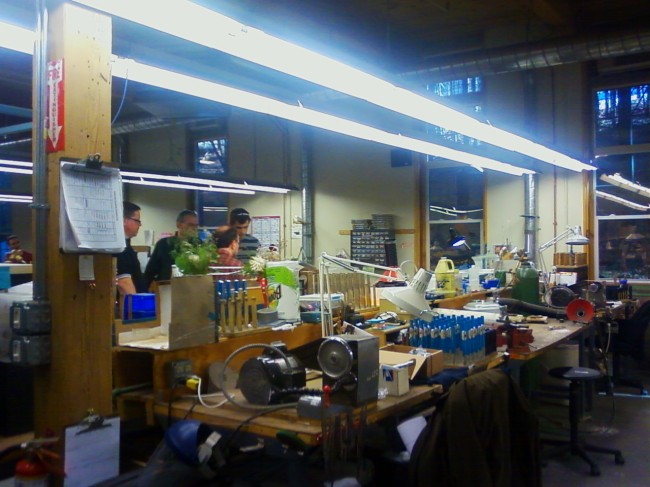I went to the Burkart Flute factory just outside of Boston a few years for a repair clinic and while the clinic itself wasn’t all that interesting, the tour of the factory defiantly was worth the trip. Burkart makes top of the line flutes with their lowest priced model starting at around $10K and their highest listed flute being close to $50K. They actually have and even more pricey model but it’s by request only. I don’t know anyone who’d spend $50,000 on a flute, but I asked one of the craftspeople how many flutes they actually sell and she told me they were backlogged a year at that point if I remember correctly.
Much of the price point is accounted for by the cost of raw materials; silver, gold, and platinum don’t exactly compare with the price of brass. Burkart had a safe full of gold and they let me hold a big piece of round silver stock that must have been about 3 pounds. Probably the most expensive thing I’ve ever had my hands on! In addition to the materials, the machines they use are very expensive as well. They had a few CNC lathes that run around half a million each as well as computerized milling machine which was very cool.
They also showed us some instrument bodies and parts they were manufacturing for other instrument makers. The owner wouldn’t tell us who they were doing work for but they had a bunch of french horn rotor assemblies as well as Oboe bodies they were making with the computerized milling machine I mentioned. That thing was amazing; once it had been programed (which was a lengthy process), it could churn out a flawless Oboe body in something like 5 minutes. The measurements were so exact that when we tested putting a rod screw through the posts, the alignment was absolutely perfect; you could drop the rod right through and it wouldn’t catch or wobble one bit.
Burkart also makes piccolos from grenadilla wood which they let season for two years before using. They told us that a big reason so many clarinets crack these days compared to times past is because the manufacturers are not waiting nearly enough time and letting the wood season properly. Apparently this is due to the shrinking numbers of the African Blackwood trees available as an increase in demand. It may be that sometime in the near future, there will be no more grenadilla instruments because of over-harvesting.
Finally, we got to see how their flutes are actually made. As you can see in the above picture, the manufacturing floor isn’t very fancy; just a big room with lots of benches and soldering torches. All the flutes made there have soldered on tone holes if memory serves and most of the parts are made from precious metals. I think it would be nerve-wracking to be soldering onto solid silver and gold body tubes all day; too much heat and you melt the thing. They told me it happened sometimes but it really wasn’t a big deal because they can just melt it down and remake it, a luxury afforded in manufacture that we defiantly do not have in the repair shop. All of the parts they use are made on site apart from pads and some screws from what I gathered. They had mini-arc welders that they used to tack the parts together before they did the silver soldering. I got to try the machine and it was very cool but I wasn’t very good at it. Oh well.
We were allowed to sort of wander around the factory floor much of the day and talk to the different people working. All of the workers do most of the different parts of the flute manufacture and rotate every so often. That seems like a good idea so people don’t get bored and when someone is out, someone else can take over a certain job if need arises. I got a chance to get my grubby fingers on some of the flute models in the show room, actually, holding those flutes might have been the most expensive things I’ve held as opposed to the silver rod, I’m not sure. Anyway, those flutes are just extraordinary: I can’t comment on the tone, I don’t play flute well enough to know, but the construction is of the absolute highest quality. Burkart uses a system called micro-Link to connect the keys to each other which is a system where there are no pins as there would be on most flutes. Visit their website to read about it because they can explain it better than I can, but generally I think the idea is to get a very tight feel with as little spring tension as possible. An added benefit would be that unlike on pinned key work, there are no pins to wear and eventually cause wobbly keys. That’s a guess on my part though so don’t quote me.
So it was a cool trip other than the fact that my junky car broke down on the way there, but that’s another boring story which I’ll spare you.

